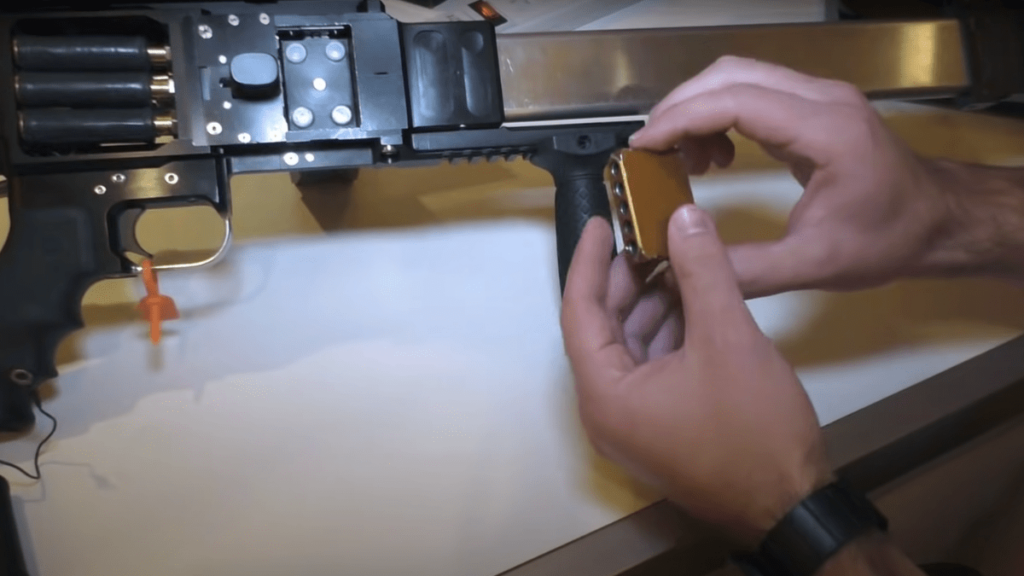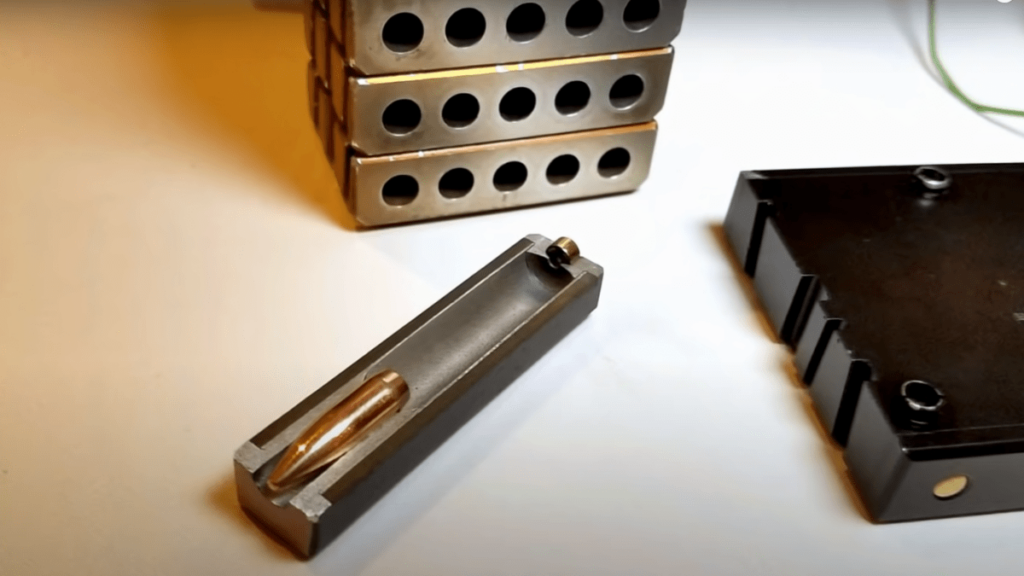Caseless ammunition is a special kind of firearm ammunition that – you might have guessed – lacks cases.
This is the simplest explanation, of course, but it still doesn’t really explain how caseless ammunition works. If ammunition lacks cases, then how is everything held together?
During the course of this article, we plan to break down caseless ammunition in its entirety. How does caseless ammunition work? Is it more or less efficient than traditional ammunition? And which type of ammunition is more affordable?
Let’s find out!
What Is Caseless Ammunition?

As noted, caseless ammunition is ammunition that lacks cases. But what does that actually mean?
In a traditional bullet, the internal components – the primer, propellant, and projectile – are held together by a case.
This case holds everything together and makes the ammunition easy to load; it also keeps the round in place once it’s chambered and ready to fire.
Caseless ammunition does away with this by incorporating the primer and propellant into the projectile itself.
This can take two forms – the propellant can be internal (e.g. placed into the base of the projectile) or external (wherein the projectile is packed into the propellant, which surrounds it).
In both cases, the primer and projectile are both consumed, meaning there is nothing to eject.
What Are The Advantages Of Caseless Ammunition?
Caseless ammunition obviously has its advantages, or it would not have been invented. What, then, are those advantages?
It’s Easier To Store
Because it doesn’t have a (relatively) bulky outer casing, caseless ammunition requires less storage space than its cased counterpart. It’s also much lighter than cased ammunition, making it more convenient to transport.
Improved Rate Of Fire
An automatic or semi-automatic weapon firing at a rapid rate needs time to eject the spent casing before chambering and firing the next.
The use of caseless ammunition precludes this; there is no spent casing to eject, so it’s possible to fire it much more rapidly.
”It’s likely that the technology surrounding caseless ammunition is only going to improve and that the ammunition will become more and more widespread in the coming years.”
This is of particular importance when firing in three-round bursts, where caseless ammunition is much more accurate than cased.
Lower Rate Of Malfunction
Because there is no case to eject, guns using caseless ammunition are far less likely to jam while in use.
This is potentially life-saving in combat situations, where a moment’s hesitation or clearing a jammed gun can be the difference between life and death.
What Are The Disadvantages Of Caseless Ammunition?

On the flip side of the coin, caseless ammunition has its drawbacks; these drawbacks have prevented it from being more widely adopted, and until the issues listed below are solved, chances are that many people will continue to prefer guns using traditional cased ammunition.
It Makes Firearms Prone To Overheating
One of the functions fulfilled by a bullet casing is that when the round is discharged, the brass casing acts as a sort of heat sink, absorbing much of the heat generated and protecting the weapon itself from any damage.
With caseless ammunition, this de facto heat sink is removed from the equation, meaning that the gun itself needs to absorb the heat.
This can lead to rapid overheating in the short term, interfering with the operation of the weapon. In the long term, it can warp the barrel and potentially ruin it completely.
The Rounds Are Prone To Storage Damage
Cased ammunition can be stored indefinitely, as the brass casing will protect the round from incidental damage and wear and tear.
Conversely, caseless ammunition is, by its very nature, highly prone to getting damaged. Internal-propellant caseless ammunition is susceptible to the projectile itself getting chipped or dented, which can interfere with its ballistic path or efficacy.
With external-propellant variants, however, the propellant itself can become compromised, which may lead to the round misfiring or decreased efficacy.
Propellant Residue Can Build Up
When a bullet is fired, there is a certain amount of residue left over from the combustion of the propellant. In the instance of cased ammunition, this residue is contained within the casing, which is then ejected from the chamber.
With caseless ammunition, that residue instead ends up building up inside the firearm, which can eventually lead to malfunctions.
Caseless Ammunition Can Be Less Powerful
One solution to the abovementioned issue is to use less propellant or to make use of a recoilless system whereby some of the propellant residues are ejected from the rear of the gun.
While this solves the problem of residue build-up, it means that the projectile is fired with much less force.
This leads to the round exiting the gun at sub-sonic speeds, which in turn leads to reduced accuracy and much less stopping power.
It’s Less Widely Supported
Cased ammunition is widespread and easily available wherever you can buy guns, making it easy to obtain and use.
Most gun vendors are also extremely familiar with it, meaning that it’s quick and simple to get advice or to deal with any issues that arise while using cased ammunition (e.g. jams).
Caseless ammunition, on the other hand, remains relatively niche – as do the firearms that can be used along with it.
This means that if you do run into maintenance problems with a firearm using caseless ammunition, it can be difficult and expensive to effect repairs.
Conclusion: Is Caseless Ammunition Better?
At present, it’s sadly the case that caseless ammunition isn’t quite as efficacious as its cased counterpart.
Despite the advantages it gains in reduced weight and space taken up, an improved rate of fire, and a lower rate of malfunction (in certain cases), the disadvantages soon pile up.
And those disadvantages are significant. With the build-up of propellant residue on the one hand or decreased projectile efficacy on the other, there’s no easy answer to the question of whether power or reliability is more important.
Furthermore, the relative lack of support for caseless ammunition means it’s much harder to get help if you do run into maintenance issues.
That said, it’s likely that the technology surrounding caseless ammunition is only going to improve and that the ammunition will become more and more widespread in the coming years.
Until then, however, it’s probably best to stick with your traditional ammo.
Want to read more about the ever-changing world of ammunition? Check out our related articles such as our guide to RIP ammo and 5 little-known Glock magazines to know about!

